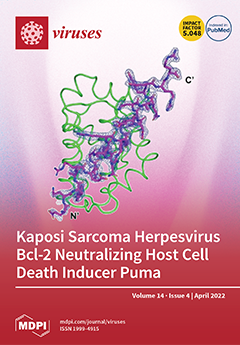Open AccessArticle
Novel Compound Inhibitors of HIV-1NL4-3 Vpu
by
Carolyn A. Robinson, Terri D. Lyddon, Hwi Min Gil, David T. Evans, Yury V. Kuzmichev, Jonathan Richard, Andrés Finzi, Sarah Welbourn, Lynn Rasmussen, N. Miranda Nebane, Vandana V. Gupta, Sam Ananthan, Zhaohui Cai, Elizabeth R. Wonderlich, Corinne E. Augelli-Szafran, Robert Bostwick, Roger G. Ptak, Susan M. Schader and Marc C. Johnson
Cited by 4 | Viewed by 3449
Abstract
HIV-1 Vpu targets the host cell proteins CD4 and BST-2/Tetherin for degradation, ultimately resulting in enhanced virus spread and host immune evasion. The discovery and characterization of small molecules that antagonize Vpu would further elucidate the contribution of Vpu to pathogenesis and lay
[...] Read more.
HIV-1 Vpu targets the host cell proteins CD4 and BST-2/Tetherin for degradation, ultimately resulting in enhanced virus spread and host immune evasion. The discovery and characterization of small molecules that antagonize Vpu would further elucidate the contribution of Vpu to pathogenesis and lay the foundation for the study of a new class of novel HIV-1 therapeutics. To identify novel compounds that block Vpu activity, we have developed a cell-based ‘gain of function’ assay that produces a positive signal in response to Vpu inhibition. To develop this assay, we took advantage of the viral glycoprotein, GaLV Env. In the presence of Vpu, GaLV Env is not incorporated into viral particles, resulting in non-infectious virions. Vpu inhibition restores infectious particle production. Using this assay, a high throughput screen of >650,000 compounds was performed to identify inhibitors that block the biological activity of Vpu. From this screen, we identified several positive hits but focused on two compounds from one structural family, SRI-41897 and SRI-42371. We developed independent counter-screens for off target interactions of the compounds and found no off target interactions. Additionally, these compounds block Vpu-mediated modulation of CD4, BST-2/Tetherin and antibody dependent cell-mediated toxicity (ADCC). Unfortunately, both SRI-41897 and SRI-42371 were shown to be specific to the N-terminal region of NL4-3 Vpu and did not function against other, more clinically relevant, strains of Vpu; however, this assay may be slightly modified to include more significant Vpu strains in the future.
Full article
►▼
Show Figures






